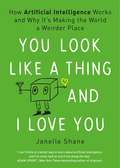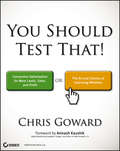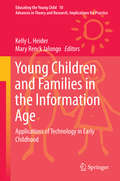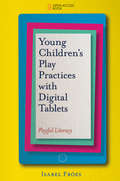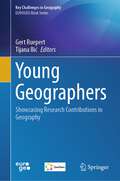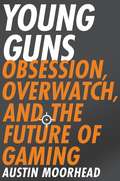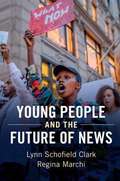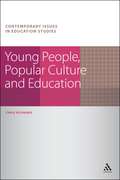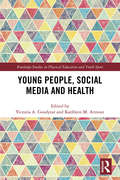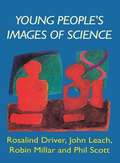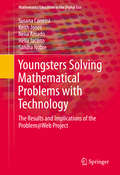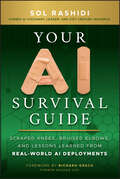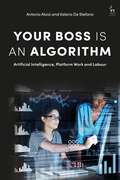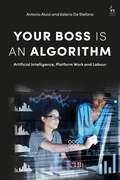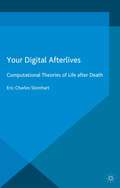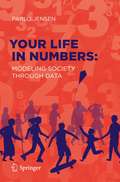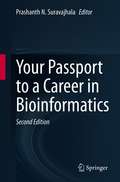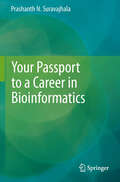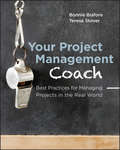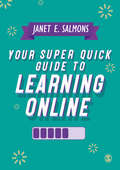- Table View
- List View
You Look Like a Thing and I Love You: How Artificial Intelligence Works And Why It's Making The World A Weirder Place
by Janelle Shane'I can't think of a better way to learn about artificial intelligence, and I've never had so much fun along the way' Adam Grant, New York Times bestselling author of Originals and Option B AI is everywhere. It powers the autocorrect function of your iPhone, helps Google Translate understand the complexity of language, and interprets your behaviour to decide which of your friends' Facebook posts you most want to see. In the coming years, it'll perform medical diagnoses and drive your car - and maybe even help our authors write the first lines of their novels. But how does it actually work?Scientist and engineer, Janelle Shane, is the go-to contributor about computer science for the New York Times, Slate, and the New Yorker. Through her hilarious experiments, real-world examples, and illuminating cartoons, she explains how AI understands our world, and what it gets wrong. More than just a working knowledge of AI, she hands readers the tools to be skeptical about claims of a smarter future.A comprehensive study of the cutting-edge technology that will soon power our world, You Look Like a Thing and I Love You is an accessible and hilarious exploration of the future of technology and society. It's Astrophysics for People In a Hurry meets Thing Explainer: an approachable guide to a fascinating scientific topic, presented with clarity, levity, and brevity by an expert in the field with a powerful and growing platform.
You Should Test That: Conversion Optimization for More Leads, Sales and Profit or The Art and Science of Optimized Marketing
by Chris GowardLearn how to convert website visitors into customers Part science and part art, conversion optimization is designed to turn visitors into customers. Carefully developed testing procedures are necessary to help you fine-tune images, headlines, navigation, colors, buttons, and every other element, creating a website that encourages visitors to take the action you seek. This book guides you through creating an optimization strategy that supports your business goals, using appropriate analytics tools, generating quality testing ideas, running online experiments, and making the adjustments that work. Conversion optimization is part science and part art; this guide provides step-by-step guidance to help you optimize your website for maximum conversion rates Explains how to analyze data, prioritize experiment opportunities, and choose the right testing methods Helps you learn what to adjust, how to do it, and how to analyze the results Features hands-on exercises, case studies, and a full-color insert reinforcing key tactics Author has used these techniques to assist Fortune 500 clients You Should Test That explains both the "why" and the "how" of conversion optimization, helping you maximize the value of your website.
You Should Test That: Conversion Optimization for More Leads, Sales and Profit or The Art and Science of Optimized Marketing
by Chris GowardLearn how to convert website visitors into customers Part science and part art, conversion optimization is designed to turn visitors into customers. Carefully developed testing procedures are necessary to help you fine-tune images, headlines, navigation, colors, buttons, and every other element, creating a website that encourages visitors to take the action you seek. This book guides you through creating an optimization strategy that supports your business goals, using appropriate analytics tools, generating quality testing ideas, running online experiments, and making the adjustments that work. Conversion optimization is part science and part art; this guide provides step-by-step guidance to help you optimize your website for maximum conversion rates Explains how to analyze data, prioritize experiment opportunities, and choose the right testing methods Helps you learn what to adjust, how to do it, and how to analyze the results Features hands-on exercises, case studies, and a full-color insert reinforcing key tactics Author has used these techniques to assist Fortune 500 clients You Should Test That explains both the "why" and the "how" of conversion optimization, helping you maximize the value of your website.
Young Children and Families in the Information Age: Applications of Technology in Early Childhood (Educating the Young Child #10)
by Kelly L. Heider Mary Renck JalongoThis edited book presents the most recent theory, research and practice on information and technology literacy as it relates to the education of young children. Because computers have made it so easy to disseminate information, the amount of available information has grown at an exponential rate, making it impossible for educators to prepare students for the future without teaching them how to be effective information managers and technology users. Although much has been written about information literacy and technology literacy in secondary education, there is very little published research about these literacies in early childhood education. Recently, the National Association for the Education of Young Children and the Fred Rogers Center for Early Learning and Children’s Media at Saint Vincent College published a position statement on using technology and interactive media as tools in early childhood programs. This statement recommends more research “to better understand how young children use and learn with technology and interactive media and also to better understand any short- and long-term effects.” Many assume that today’s young children are “digital natives” with a great understanding of technology. However, children may know how to operate digital technology but be unaware of its dangers or its value to extend their abilities. This book argues that information and technology literacy include more than just familiarity with the digital environment. They include using technology safely and ethically to demonstrate creativity and innovation; to communicate and collaborate; to conduct research and use information and to think critically, solve problems and make decisions.
Young Children’s Play Practices with Digital Tablets: Playful Literacy
by Isabel FróesThe ebook version of this title is Open Access, thanks to Knowledge Unlatched funding, and is freely available to read online. This book presents how young children's current practices when playing with tablets inform digital experiences in Denmark and Japan. Through an interdisciplinary lens and a grounded theory approach, Fróes identifies and maps these practices, which compose the taxonomy of tablet play and proposes a series of theoretical concepts that complement recent theories related to play and digital literacy studies. Tablet devices bring with them not only a multitude of options, but they also help create notions of digital space and environments defining emerging territories in young children's play experiences. Young children play with these devices and have fun indulging in digital worlds, while discovering and problem-solving with a variety of narratives and interfaces encountered on these digital playgrounds. A set of tablet play characteristics, such as multimodal applications (apps) combined with tablets' physical and digital affordances shape children's digital play. The data collected through observations informed some noteworthy aspects, including how children's hands gain and perform an embodied knowledge of digital spaces. This embodied knowledge develops through digital play interactions, defining what is proposed as digital penmanship. Complementary to the penmanship, several symbols and a range of modes of use shape a rich multimodal semiotic vocabulary in children's digital play experiences. These early digital experiences set the rules for the playgrounds and assert digital tablets as twenty-first-century toys, shaping young children's playful literacy.
Young Children’s Play Practices with Digital Tablets: Playful Literacy
by Isabel FróesThe ebook version of this title is Open Access, thanks to Knowledge Unlatched funding, and is freely available to read online. This book presents how young children's current practices when playing with tablets inform digital experiences in Denmark and Japan. Through an interdisciplinary lens and a grounded theory approach, Fróes identifies and maps these practices, which compose the taxonomy of tablet play and proposes a series of theoretical concepts that complement recent theories related to play and digital literacy studies. Tablet devices bring with them not only a multitude of options, but they also help create notions of digital space and environments defining emerging territories in young children's play experiences. Young children play with these devices and have fun indulging in digital worlds, while discovering and problem-solving with a variety of narratives and interfaces encountered on these digital playgrounds. A set of tablet play characteristics, such as multimodal applications (apps) combined with tablets' physical and digital affordances shape children's digital play. The data collected through observations informed some noteworthy aspects, including how children's hands gain and perform an embodied knowledge of digital spaces. This embodied knowledge develops through digital play interactions, defining what is proposed as digital penmanship. Complementary to the penmanship, several symbols and a range of modes of use shape a rich multimodal semiotic vocabulary in children's digital play experiences. These early digital experiences set the rules for the playgrounds and assert digital tablets as twenty-first-century toys, shaping young children's playful literacy.
Young Geographers: Showcasing Research Contributions in Geography (Key Challenges in Geography)
by Gert Ruepert Tijana IlićThis book shows an updated overview of research about human geography topics like urban growth/urban challenges, transportation, landscape, land cover, geospatial analysis, regional planning/local development, cultural geography, tourism, and so on. Between 2020 and 2022, due to COVID-19 and lockdowns worldwide, there were fewer opportunities for young and upcoming researchers to present their state-of-the-art findings at conferences. In order to highlight exceptional research of young geographers during this time, the idea for this book was created. In collaboration with the EGEA alumni foundation for students and young geographers, 12 authors were selected to showcase their scientific work. In addition to that, most of them present amazing maps and figures as outstanding expression of the need of GIS for geography research.
Young Guns: Obsession, Overwatch, and the Future of Gaming
by Austin MoorheadMoneyball meets Bringing Down the House in the behind-the-scenes dramatic story of the rise of global pro gaming leaguesWelcome to the high-stakes world of esports where shit-talking teenage gamers, billionaire sports franchise owners, and celebrity entrepreneurs are all competing to understand and conquer the fast-emerging future of entertainment. The burgeoning frontier of professional gaming has moved beyond the niche corners of the internet to become a global phenomenon, upending youth viewership for the major sports leagues and opening a generational rift over the nature of "athletics." Soon, professional video game competitions may well be as ingrained in our culture as Monday Night Football. YOUNG GUNS: Obsession, Overwatch, and the Future of Gaming takes readers behind the scenes of the esports boom and into the lives of the gamers and game changers leading the charge, unfurling a wry, unexpected, and often hilarious narrative about the rise of professional gaming and the business of electronic sports. An avid gamer himself, author Austin Moorhead became fascinated by pro gaming, in particular the Overwatch League (OWL) after sports titans Robert Kraft, Stan Kroenke, and Jeff Wilpon each paid $20 million for a team. At the same time that he began investigating the inner-workings of the league, OWL launched esports into the American mainstream, inking TV deals with ABC and ESPN, selling out NBA stadiums for live competitions, and minting a new version of young pro athletes. Embedding with two top teams in the Overwatch League, the San Francisco Shock and the London Spitfire, as they embark on the inaugural season, Moorhead pulls back the curtain on the grueling practice schedules and spartan lifestyles of the league's most popular players. In addition to the "gamer houses" and competitions in which the pros hone their skills, Moorhead takes readers into the board room of Overwatch-developer Blizzard Entertainment, where entrepreneurs eager to capitalize on youth culture take bets on new esports franchises for tens of millions. The result is a rollicking story about the superstars of the future and the absurd collision of adolescent prodigies and high-stakes industry, an uproarious look at the future of sports and entertainment that is part Bringing Down the House, part Moneyball.
Young People And The Future Of News: Social Media And The Rise Of Connective Journalism (Communication, Society And Politics Ser. (PDF))
by Lynn Nbsp Schofield Clark Regina MarchiYoung People and the Future of News traces the practices that are evolving as young people come to see news increasingly as something shared via social networks and social media rather than produced and circulated solely by professional news organizations. The book introduces the concept of connective journalism, clarifying the role of creating and sharing stories online as a key precursor to collective and connective political action. At the center of the story are high school students from low-income minority and immigrant communities who often feel underserved or misrepresented by mainstream media but express a strong interest in politics and their communities. Drawing on in-depth field work in three major urban areas over the course of ten years, Young People and the Future of News sheds light on how young people share news that they think others should know about, express solidarity, and bring into being new publics and counter-publics.
Young People, Popular Culture and Education (Contemporary Issues in Education Studies)
by Chris Richards Richard Race Simon Pratt-AdamsWritten to support the Education Studies student with full pedagogical features throughout, this book explores the inter-relationship between the three fields and considers how these relationships have informed teaching practice, especially in the school context.
Young People, Social Media and Health (Routledge Studies in Physical Education and Youth Sport)
by Victoria A. Goodyear Kathleen M. ArmourThe Open Access version of this book, available at http://www.tandfebooks.com/doi/view/10.4324/9781351026987, has been made available under a Creative Commons Attribution-Non Commercial-No Derivatives 4.0 license The pervasiveness of social media in young people’s lives is widely acknowledged, yet there is little evidence-based understanding of the impacts of social media on young people’s health and wellbeing. Young People, Social Media and Health draws on novel research to understand, explain, and illustrate young people’s experiences of engagement with health-related social media; as well as the impacts they report on their health, wellbeing, and physical activity. Using empirical case studies, digital representations, and evidence from multi-sector and interdisciplinary stakeholders and academics, this volume identifies the opportunities and risk-related impacts of social media. Offering new theoretical insights and practical guidelines for educators, practitioners, parents/guardians, and policy makers; Young People, Social Media and Health will also appeal to students and researchers interested in fields such as Sociology of Sport, Youth Sports Development, Secondary Physical Education, and Media Effects.
Young People, Social Media and Health (Routledge Studies in Physical Education and Youth Sport)
by Victoria Goodyear Kathleen ArmourThe Open Access version of this book, available at http://www.tandfebooks.com/doi/view/10.4324/9781351026987, has been made available under a Creative Commons Attribution-Non Commercial-No Derivatives 4.0 license The pervasiveness of social media in young people’s lives is widely acknowledged, yet there is little evidence-based understanding of the impacts of social media on young people’s health and wellbeing. Young People, Social Media and Health draws on novel research to understand, explain, and illustrate young people’s experiences of engagement with health-related social media; as well as the impacts they report on their health, wellbeing, and physical activity. Using empirical case studies, digital representations, and evidence from multi-sector and interdisciplinary stakeholders and academics, this volume identifies the opportunities and risk-related impacts of social media. Offering new theoretical insights and practical guidelines for educators, practitioners, parents/guardians, and policy makers; Young People, Social Media and Health will also appeal to students and researchers interested in fields such as Sociology of Sport, Youth Sports Development, Secondary Physical Education, and Media Effects.
Young People's Images of Science (UK Higher Education OUP Humanities & Social Sciences Education OUP)
by Rosalind Driver John Leach Robin Millar Phil Scott* What ideas about science do school students form as a result of their experiences in and out of school?* How might science teaching in schools develop a more scientifically-literate society?* How do school students understand disputes about scientific issues including those which have social significance, such as the irradiation of food?There have been calls in the UK and elsewhere for a greater public understanding of science underpinned by, amongst other things, school science education. However, the relationship between school science, scientific literacy and the public understanding of science remains controversial.In this book, the authors argue that an understanding of science goes beyond learning the facts, laws and theories of science and that it involves understanding the nature of scientific knowledge itself and the relationships between science and society. Results of a major study into the understanding of these issues by school students aged 9 to 16 are described. These results suggest that the success of the school science curriculum in promoting this kind of understanding is at best limited.The book concludes by discussing ways in which the school science curriculum could be adapted to better equip students as future citizens in our modern scientific and technological society. It will be particularly relevant to science teachers, advisers and inspectors, teacher educators and curriculum planners.
Youngsters Solving Mathematical Problems with Technology: The Results and Implications of the Problem@Web Project (Mathematics Education in the Digital Era #5)
by Susana Carreira Keith Jones Nélia Amado Hélia Jacinto Sandra NobreThis book contributes to both mathematical problem solving and the communication of mathematics by students, and the role of personal and home technologies in learning beyond school. It does this by reporting on major results and implications of the Problem@Web project that investigated youngsters’ mathematical problem solving and, in particular, their use of digital technologies in tackling, and communicating the results of their problem solving, in environments beyond school. The book has two focuses: Mathematical problem solving skills and strategies, forms of representing and expressing mathematical thinking, technological-based solutions; and students´ and teachers´ perspectives on mathematics learning, especially school compared to beyond-school mathematics.
Your AI Survival Guide: Scraped Knees, Bruised Elbows, and Lessons Learned from Real-World AI Deployments
by Sol RashidiPractical and proven AI deployment strategies for non-technical business leaders In Your AI Survival Guide: Scraped Knees, Bruised Elbows, and Lessons Learned from Real-World AI Deployments, business executive and technologist Sol Rashidi delivers an insightful and practical discussion of how to deploy artificial intelligence in your company. Having helped IBM launch Watson in 2011, Sol has first-hand knowledge of the ups, downs, and change management intricacies that can help you with a successful deployment beyond all the AI hype. She walks you through various frameworks for how to establish your AI strategy, pick your use cases, prepare your non-technology teams, and overcome the most common obstacles standing in the way of successfully implementing AI in your business, based on her many years of deploying AI projects in businesses, which few can claim. Sol demystifies the topic of artificial intelligence in a way that business leaders and business owners—and those who want to be more business minded—can easily understand. The book also offers: Real-world use cases from ten different industries, including retail, healthcare, energy, insurance, agriculture, and more; ten different functions, including supply chain, manufacturing, procurement, legal, and more; and personal stories, anecdotes, and insights gained from implementations Techniques for facilitating executive-level buy-in for your most ambitious and promising AI strategies Jargon-free and accessible language that simplifies a seemingly complicated topic And practical advice that’s not based on AI hype Perfect for executives, managers, directors, founders, entrepreneurs, practitioners and other non-technical business leaders, Your AI Survival Guide is the ideal guide to help you deploy artificial intelligence in your business and increase your chances of success whether your business goal is top-line growth, increased productivity, or efficiency gains without having to add headcount as the go-to answer.
Your AI Survival Guide: Scraped Knees, Bruised Elbows, and Lessons Learned from Real-World AI Deployments
by Sol RashidiPractical and proven AI deployment strategies for non-technical business leaders In Your AI Survival Guide: Scraped Knees, Bruised Elbows, and Lessons Learned from Real-World AI Deployments, business executive and technologist Sol Rashidi delivers an insightful and practical discussion of how to deploy artificial intelligence in your company. Having helped IBM launch Watson in 2011, Sol has first-hand knowledge of the ups, downs, and change management intricacies that can help you with a successful deployment beyond all the AI hype. She walks you through various frameworks for how to establish your AI strategy, pick your use cases, prepare your non-technology teams, and overcome the most common obstacles standing in the way of successfully implementing AI in your business, based on her many years of deploying AI projects in businesses, which few can claim. Sol demystifies the topic of artificial intelligence in a way that business leaders and business owners—and those who want to be more business minded—can easily understand. The book also offers: Real-world use cases from ten different industries, including retail, healthcare, energy, insurance, agriculture, and more; ten different functions, including supply chain, manufacturing, procurement, legal, and more; and personal stories, anecdotes, and insights gained from implementations Techniques for facilitating executive-level buy-in for your most ambitious and promising AI strategies Jargon-free and accessible language that simplifies a seemingly complicated topic And practical advice that’s not based on AI hype Perfect for executives, managers, directors, founders, entrepreneurs, practitioners and other non-technical business leaders, Your AI Survival Guide is the ideal guide to help you deploy artificial intelligence in your business and increase your chances of success whether your business goal is top-line growth, increased productivity, or efficiency gains without having to add headcount as the go-to answer.
Your Boss Is an Algorithm: Artificial Intelligence, Platform Work and Labour
by Antonio Aloisi Valerio De StefanoWhat effect do robots, algorithms, and online platforms have on the world of work? Using case studies and examples from across the EU, the UK, and the US, this book provides a compass to navigate this technological transformation as well as the regulatory options available, and proposes a new map for the era of radical digital advancements.From platform work to the gig-economy and the impact of artificial intelligence, algorithmic management, and digital surveillance on workplaces, technology has overwhelming consequences for everyone's lives, reshaping the labour market and straining social institutions. Contrary to preliminary analyses forecasting the threat of human work obsolescence, the book demonstrates that digital tools are more likely to replace managerial roles and intensify organisational processes in workplaces, rather than opening the way for mass job displacement.Can flexibility and protection be reconciled so that legal frameworks uphold innovation? How can we address the pervasive power of AI-enabled monitoring? How likely is it that the gig-economy model will emerge as a new organisational paradigm across sectors? And what can social partners and political players do to adopt effective regulation?Technology is never neutral. It can and must be governed, to ensure that progress favours the many. Digital transformation can be an essential ally, from the warehouse to the office, but it must be tested in terms of social and political sustainability, not only through the lenses of economic convenience. Your Boss Is an Algorithm offers a guide to explore these new scenarios, their promises, and perils.
Your Boss Is an Algorithm: Artificial Intelligence, Platform Work and Labour
by Antonio Aloisi Valerio De StefanoWhat effect do robots, algorithms, and online platforms have on the world of work? Using case studies and examples from across the EU, the UK, and the US, this book provides a compass to navigate this technological transformation as well as the regulatory options available, and proposes a new map for the era of radical digital advancements.From platform work to the gig-economy and the impact of artificial intelligence, algorithmic management, and digital surveillance on workplaces, technology has overwhelming consequences for everyone's lives, reshaping the labour market and straining social institutions. Contrary to preliminary analyses forecasting the threat of human work obsolescence, the book demonstrates that digital tools are more likely to replace managerial roles and intensify organisational processes in workplaces, rather than opening the way for mass job displacement.Can flexibility and protection be reconciled so that legal frameworks uphold innovation? How can we address the pervasive power of AI-enabled monitoring? How likely is it that the gig-economy model will emerge as a new organisational paradigm across sectors? And what can social partners and political players do to adopt effective regulation?Technology is never neutral. It can and must be governed, to ensure that progress favours the many. Digital transformation can be an essential ally, from the warehouse to the office, but it must be tested in terms of social and political sustainability, not only through the lenses of economic convenience. Your Boss Is an Algorithm offers a guide to explore these new scenarios, their promises, and perils.
Your Digital Afterlives: Computational Theories of Life after Death (Palgrave Frontiers in Philosophy of Religion)
by E. SteinhartDigitalism is a philosophical strategy that uses new computational ways of thinking to develop naturalistic but meaningful ways of thinking about bodies, souls, universes, gods, and life after death. Your Digital Afterlives examines four recently developed and digitally inspired theories of life after death.
Your Life in Numbers: Modeling Society Through Data
by Pablo JensenMore than 300 years ago, Isaac Newton created a mathematical model of the solar system that predicted the existence of a yet unknown planet: Neptune. Today, driven by the digital revolution, modern scientists are creating complex models of society itself to shed light on topics as far-ranging as epidemic outbreaks and economic growth. But how do these scientists gather and interpret their data? How accurate are their models? Can we trust the numbers? With a rare background in physics, economics and sociology, the author is able to present an insider’s view of the strengths, weaknesses and dangers of transforming our lives into numbers. After reading this book, you’ll understand how different numerical models work and how they are used in practice. The author begins by exploring several simple, easy-to-understand models that form the basis for more complex simulations. What follows is an exploration of the myriad ways that models have come to describe and define our world, from epidemiology and climate change to urban planning and the world chess championship. Highly engaging and nontechnical, this book will appeal to any readers interested in understanding the links between data and society and how our lives are being increasingly captured in numbers.
Your Passport to a Career in Bioinformatics
by Prashanth N. SuravajhalaThis book which is the second edition of Your Passport to a Career in Bioinformatics, is intended for students who plan to work in bioinformatics. In addition to addressing the opportunities and challenges faced by today’s bioinformatics community, it demonstrates how bioinformatics is currently transitioning from research to vocation and avocation. Further, it extols the virtues of in silico for bioinformatics predictions, as it helps wet-lab biologists reduce the time needed for experiments.In turn, the book addresses career prospects and the Ten Commandments for becoming a bioinformatics professional; bioinformatics for developing countries; bioinformatics for schools; bioinformatics for markets; and the knowns and unknowns of bioinformatics. It also explores how bioinformatics interacts with various fields in terms of three Cs: consistency, continuity, and credibility.
Your Passport to a Career in Bioinformatics
by Prashanth N SuravajhalaThe book is a ready reckoner aimed at the student community aspiring to take up a career in bioinformatics. The book firstly provides a perspective on the domain and addresses the challenges faced by community namely the attempts to understand data produced by genome sequencing projects. It then brings to light High Performance Computing (HPC) as it helps in interpreting and analyzing genome sequences. The book also dwells on how interactions in a systems (organism), the components that interact with each other and the outcome of such interactions. It then calls for a consensus on the tools like rapid and inexpensive DNA sequencing technologies, HAPMAP projects, Dollar One Genome (DOG), to enable a reader understand how bioinformatics transits from research, to vocation and avocation. Further it extols the virtues of in silico for bioinformatical predictions as it helps wet-lab biologists reduce time for experiments. Also it describes the intricacies of bioinformatics and its usefulness to wet-based biologists and other cross-disciplinarians. The book lists out 10 reasons for taking up bioinformatics as a career, and includes insights from global experts on the domain. It also makes a case for a mediocre student getting into bioinformatics with discipline, determination, dynamism and diligence. The book further describes BioinformaTICKS a tool for emerging as a winner in bioinformatics.
Your Project Management Coach: Best Practices for Managing Projects in the Real World
by Bonnie Biafore Teresa StoverA pragmatic approach to project management Many projects fail to deliver on time or on budget, or even to deliver a workable product that satisfies the customer. While good project management goes a long way towards ensuring success, managers often fail to follow the plans they implement. This unique guide helps you understand and successfully handle project management, once and for all. Covering practical ways to solve problems you'll typically face when managing actual projects, this pragmatic book takes you through a full project management lifecycle. You'll find ample tips, tricks, and best practices--all richly illustrated with real case studies. Find out how to plan for risk, get wayward projects back on track, manage a whole portfolio of projects, and much more. Each topic in the book is mapped to the exam topics of the PMP® Certification Exam, so PMP certification candidates can also use this book for test prep. The book's companion web site offers downloadable forms, templates, and checklists. Explains project management for the real world using a pragmatic approach that includes field-tested techniques, case studies to illustrate concepts, helpful tips and tricks, and downloadable content Guides you to project management success by providing friendly advice, as if you had a friend or project management consultant at your side, discussing issues Explores how to run successful meetings, how to get wayward projects back on track, planning for risk, and how to manage multiple projects Manage your next project with a personal consultant: your own copy of Your Project Management Coach: Best Practices for Managing Projects in the Real World. (PMP is a registered marks of the Project Management Institute, Inc.)
Your Project Management Coach: Best Practices for Managing Projects in the Real World
by Bonnie Biafore Teresa StoverA pragmatic approach to project management Many projects fail to deliver on time or on budget, or even to deliver a workable product that satisfies the customer. While good project management goes a long way towards ensuring success, managers often fail to follow the plans they implement. This unique guide helps you understand and successfully handle project management, once and for all. Covering practical ways to solve problems you'll typically face when managing actual projects, this pragmatic book takes you through a full project management lifecycle. You'll find ample tips, tricks, and best practices--all richly illustrated with real case studies. Find out how to plan for risk, get wayward projects back on track, manage a whole portfolio of projects, and much more. Each topic in the book is mapped to the exam topics of the PMP® Certification Exam, so PMP certification candidates can also use this book for test prep. The book's companion web site offers downloadable forms, templates, and checklists. Explains project management for the real world using a pragmatic approach that includes field-tested techniques, case studies to illustrate concepts, helpful tips and tricks, and downloadable content Guides you to project management success by providing friendly advice, as if you had a friend or project management consultant at your side, discussing issues Explores how to run successful meetings, how to get wayward projects back on track, planning for risk, and how to manage multiple projects Manage your next project with a personal consultant: your own copy of Your Project Management Coach: Best Practices for Managing Projects in the Real World. (PMP is a registered marks of the Project Management Institute, Inc.)
Your Super Quick Guide to Learning Online
by Janet SalmonsLearn how to successfully adapt to online remote learning with this super quick guide. Packed with pragmatic, applied tips on how to adjust to a digital learning experience, this handy resource will instil you with the confidence and know-how needed to succeed. Set up an effective workplace and stay motivated Work well with tutors and get the support you need Get the most out of different forms of learning, from lectures to field work Make the best use of materials, such as online databases and open-access content. Collaborate effectively with peers and create your best work. An invaluable guide to get you through university cool, calm and in control!
